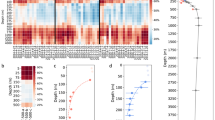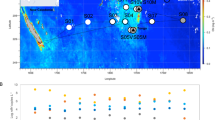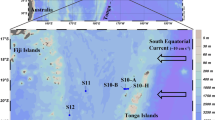Abstract
Phytoplankton growth is potentially limited by the scarcity of biologically available forms of nitrogen such as nitrate and ammonium. In the subtropical ocean gyres, water column stratification impedes the upward flux of nitrate to surface waters. Phytoplankton in these waters are assumed to rely largely on ammonium and other forms of nitrogen recycled during the breakdown of organic matter. Here, we use flow cytometry to separate prokaryotic and eukaryotic phytoplankton collected from Sargasso Sea surface waters in the summers of 2008 and 2009, and to analyse their respective nitrogen isotope ratios. We show that prokaryotes have a uniformly low ratio of 15N to 14N, δ15N, consistent with their reliance on recycled nitrogen. In contrast, small eukaryotic phytoplankton, less than 30 μm in size, have a higher and more variable δ15N, with a mean value similar to that of nitrate in underlying Subtropical Mode Water. For the summertime Sargasso Sea, we estimate that small eukaryotes obtain more than half of their nitrogen from upwelled nitrate. In addition, our data support the view that sinking material derives largely from eukaryotic, not prokaryotic, phytoplankton biomass.
This is a preview of subscription content, access via your institution
Access options
Subscribe to this journal
Receive 12 print issues and online access
$259.00 per year
only $21.58 per issue
Buy this article
- Purchase on Springer Link
- Instant access to full article PDF
Prices may be subject to local taxes which are calculated during checkout



Similar content being viewed by others
References
Dugdale, R. C. & Goering, J. J. Uptake of new and regenerated forms of nitrogen in primary production. Limnol. Oceanogr. 12, 196–206 (1967).
Eppley, R. W. & Peterson, B. J. Particulate organic matter flux and planktonic new production in the deep ocean. Nature 282, 677–680 (1979).
Menzel, D. W. & Ryther, J. H. The annual cycle of primary production in the Sargasso Sea off Bermuda. Deep-Sea Res. 6, 351–367 (1960).
Lipschultz, F. A time-series assessment of the nitrogen cycle at BATS. Deep-Sea Res. II 48, 1897–1924 (2001).
Steinberg, D. K. et al. Overview of the US JGOFS Bermuda Atlantic Time-series Study (BATS): A decade-scale look at ocean biology and biogeochemistry. Deep-Sea Res. II 48, 1405–1447 (2001).
Chisholm, S. W. et al. novel free-living prochlorophyte abundant in the oceanic euphotic zone. Nature 334, 340–343 (1988).
Waterbury, J. B., Watson, S., Guillard, R. R. L. & Brand, L. E. Widespread occurrence of a unicellular, marine, planktonic, cyanobacterium. Nature 277, 293–294 (1979).
DuRand, M. D., Olson, R. J. & Chisholm, S. W. Phytoplankton population dynamics at the Bermuda Atlantic Time-series station in the Sargasso Sea. Deep-Sea Res. II 48, 1983–2003 (2001).
Altabet, M. A. Variations in nitrogen isotopic composition between sinking and suspended particles: Implications for nitrogen cycling and particle transformation in the open ocean. Deep-Sea Res. 35, 535–554 (1988).
Altabet, M. A. A time-series study of the vertical structure of nitrogen and particle dynamics in the Sargasso Sea. Limnol. Oceanogr. 34, 1185–1201 (1989).
Knapp, A. N., Sigman, D. M. & Lipschultz, F. N isotopic composition of dissolved organic nitrogen and nitrate at the Bermuda Atlantic Time-series Study site. Glob. Biogeochem. Cycles 19, 1–15 (2005).
Saino, T. & Hattori, A. Geographical variation of the water column distribution of suspended particulate organic nitrogen and its 15N natural abundance in the Pacific and its marginal seas. Deep-Sea Res. I 34, 807–827 (1987).
Carpenter, E. J., Harvey, H. R., Fry, B. & Capone, D. G. Biogeochemical tracers of the marine cyanobacterium Trichodesmium. Deep-Sea Res. I 44, 27–38 (1997).
Minagawa, M. & Wada, E. Nitrogen isotope ratios of red tide organisms in the East China Sea—a characterization of biological nitrogen-fixation. Mar. Chem. 19, 245–259 (1986).
Checkley, D. M. Jr & Miller, C. A. Nitrogen isotope fractionation by oceanic zooplankton. Deep-Sea Res. 36, 1449–1456 (1989).
Montoya, J. P., Carpenter, E. J. & Capone, D. G. Nitrogen fixation and nitrogen isotope abundances in zooplankton of the oligotrophic North Atlantic. Limnol. Oceanogr. 47, 1617–1628 (2002).
Rau, G. H., Teyssie, J. L., Rassoulzadegan, F. & Fowler, S. W. 13C/12C and 15N/14N variations among size-fractionated marine particles—implications for their origin and trophic relationships. Mar. Ecol.-Prog. Ser. 59, 33–38 (1990).
Moore, L. R., Post, A. F., Rocap, G. & Chisholm, S. W. Utilization of different nitrogen sources by the marine cyanobacteria Prochlorococcus and Synechococcus. Limnol. Oceanogr. 47, 989–996 (2002).
Hansell, D. A. & Carlson, C. A. Biogeochemistry of total organic carbon and nitrogen in the Sargasso Sea: Control by convective overturn. Deep-Sea Res. II 48, 1649–1667 (2001).
Macko, S. A., Estep, M. L. F., Engel, M. H. & Hare, P. E. Kinetic fractionation of stable nitrogen isotopes during amino-acid transamination. Geochim. Cosmochim. Acta 50, 2143–2146 (1986).
Silfer, J. A., Engel, M. H. & Macko, S. A. Kinetic fractionation of stable carbon and nitrogen isotopes during peptide-bond hydrolysis—experimental evidence and geochemical implications. Chem. Geol. 101, 211–221 (1992).
Knapp, A. N., Sigman, D. M., Lipschultz, F., Kustka, A. & Capone, D. G. Interbasin isotopic correspondence between upper-ocean bulk DON and subsurface nitrate and its implications for marine nitrogen cycling. Glob. Biogeochem. Cycles. (in the press).
Zubkov, M. V., Fuchs, B. M., Tarran, G. A., Burkill, P. H. & Amann, R. High rate of uptake of organic nitrogen compounds by Prochlorococcus cyanobacteria as a key to their dominance in oligotrophic oceanic waters. Appl. Environ. Microbiol. 69, 1299–1304 (2003).
Wawrik, B., Callaghan, A. V. & Bronk, D. A. Use of inorganic and organic nitrogen by Synechococcus spp. and diatoms on the West Florida shelf as measured using stable isotope probing. Appl. Environ. Microbiol. 75, 6662–6670 (2009).
Lomas, M. W. & Lipschultz, F. Forming the primary nitrite maximum: Nitrifiers or phytoplankton. Limnol. Oceanogr. 51, 2453–2467 (2006).
Hoch, M. P., Fogel, M. L. & Kirchman, D. L. Isotope fractionation associated with ammonium uptake by a marine bacterium. Limnol. Oceanogr. 37, 1447–1459 (1992).
DiFiore, P. J., Sigman, D. M. & Dunbar, R. B. Upper ocean nitrogen fluxes in the Polar Antarctic Zone: Constraints from the nitrogen and oxygen isotopes of nitrate. Geochem. Geophys. Geosyst. 10, Q11016 (2009).
Harrison, W. G., Harris, L. R. & Irwin, B. D. The kinetics of nitrogen utilization in the oceanic mixed layer: Nitrate and ammonium interactions at nanomolar concentrations. Limnol. Oceanogr. 41, 16–32 (1996).
Granger, J., Sigman, D. M., Lehmann, M. F. & Tortell, P. D. Nitrogen and oxygen isotope fractionation during dissimilatory nitrate reduction by denitrifying bacteria. Limnol. Oceanogr. 53, 2533–2545 (2008).
Villareal, T. A. et al. Upward transport of oceanic nitrate by migrating diatom mats. Nature 397, 423–425 (1999).
Goericke, R. Response of phytoplankton community structure and taxon-specific growth rates to seasonally varying physical forcing in the Sargasso Sea off Bermuda. Limnol. Oceanogr. 43, 921–935 (1998).
Cochlan, W. P. & Harrison, P. J. Inhibition of nitrate uptake by ammonium and urea in the eucaryotic picoflagellate Micromonas pusilla (Butcher) Manton et Parke. J. Exp. Mar. Biol. Ecol. 153, 143–152 (1991).
McGillicuddy, D. J. Jr et al. Influence of mesoscale eddies on new production in the Sargasso Sea. Nature 394, 263–266 (1998).
Johnson, K. S., Riser, S. C. & Karl, D. M. Nitrate supply from the deep to near-surface waters of the North Pacific subtropical gyre. Nature 465, 1062–1065 (2010).
Katija, K. & Dabiri, J. O. A viscosity-enhanced mechanism for biogenic ocean mixing. Nature 460, 624–626 (2009).
Jenkins, W. J. Studying subtropical thermocline ventilation and circulation using tritium and 3He. J. Geophys. Res. 103, 15817–15831 (1998).
Fenchel, T., King, G. M. & Blackburn, T. H. Bacterial Biogeochemistry: The Ecophysiology of Mineral Cycling (Elsevier Academic Press, 1998).
Ducklow, H. W., Purdie, D. A., Williams, P. J. L. & Davies, J. M. Bacterioplankton—a sink for carbon in a coastal marine plankton community. Science 232, 865–867 (1986).
Altabet, M. A. & Small, L. F. Nitrogen isotopic ratios in fecal pellets produced by marine zooplankton. Geochim. Cosmochim. Acta 54, 155–163 (1990).
Montoya, J. P., Wiebe, P. H. & McCarthy, J. J. Natural abundance of 15N in particulate nitrogen and zooplankton in the Gulf Stream region and warm-core ring 86a. Deep-Sea Res. I 39, S363–S392 (1992).
Tamelander, T., Soreide, J. E., Hop, H. & Carroll, M. L. Fractionation of stable isotopes in the Arctic marine copepod Calanus glacialis: Effects on the isotopic composition of marine particulate organic matter. J. Exp. Mar. Biol. Ecol. 333, 231–240 (2006).
Harbison, G. R. & McAlister, V. L. Filter-feeding rates and particle retention efficiencies of 3 species of Cyclosalpa (Tunicata, Thaliacea). Limnol. Oceanogr. 24, 875–892 (1979).
Schnetzer, A. & Steinberg, D. K. Natural diets of vertically migrating zooplankton in the Sargasso Sea. Mar. Biol. 141, 403 (2002).
Lomas, M. W. & Moran, S. B. Evidence for aggregation and export of cyanobacteria and nano-eukaryotes from the Sargasso Sea euphotic zone. Biogeosciences 8, 203–216 (2011).
Michaels, A. F. & Silver, M. W. Primary production, sinking fluxes and the microbial food web. Deep-Sea Res. 35, 473–490 (1988).
Richardson, T. L. & Jackson, G. A. Small phytoplankton and carbon export from the surface ocean. Science 315, 838–840 (2007).
Casey, J. R. et al. Phytoplankton taxon-specific orthophosphate (Pi) and ATP utilization in the western subtropical North Atlantic. Aquat. Microbial. Ecol. 58, 31–44 (2009).
Braman, R. S. & Hendrix, S. A. Nanogram nitrite and nitrate determination in environmental and biological materials by vanadium(III) reduction with chemiluminescence detection. Anal. Chem. 61, 2715–2718 (1989).
Sigman, D. M. et al. A bacterial method for the nitrogen isotopic analysis of nitrate in seawater and freshwater. Anal. Chem. 73, 4145–4153 (2001).
Casciotti, K. L., Sigman, D. M., Hastings, M. G., Böhlke, J. K. & Hilkert, A. Measurement of the oxygen isotopic composition of nitrate in seawater and freshwater using the denitrifier method. Anal. Chem. 74, 4905–4912 (2002).
Acknowledgements
We thank A. Babbin, S. Bell, J. Granger, A. Knapp, H. Ren and L. Treibergs, the staff of the Bermuda Institute of Ocean Sciences and the captain and crew of the R/V Atlantic Explorer. We also thank B. Plessen at GeoForschungsZentrum, Potsdam, for analysis of bulk PN samples from July 2008. N. Levine pointed us towards the possible impacts of Hurricane Bertha. This work was supported by the Charrock Foundation, by the Siebel Energy Grand Challenge of Princeton University, and by the US NSF through grants OCE-0752161 (M.W.L.), OCE-0452162 (B.B.W.) and OCE-0447570 (D.M.S.). This is BIOS contribution no. 2028.
Author information
Authors and Affiliations
Contributions
M.W.L. and D.M.S. suggested the research area, S.E.F., M.W.L., B.B.W. and D.M.S. planned the project, S.E.F. and J.R.C. performed most of the work, and all authors wrote the paper, led by S.E.F.
Corresponding author
Ethics declarations
Competing interests
The authors declare no competing financial interests.
Supplementary information
Supplementary Information
Supplementary Information (PDF 2104 kb)
Rights and permissions
About this article
Cite this article
Fawcett, S., Lomas, M., Casey, J. et al. Assimilation of upwelled nitrate by small eukaryotes in the Sargasso Sea. Nature Geosci 4, 717–722 (2011). https://doi.org/10.1038/ngeo1265
Received:
Accepted:
Published:
Issue Date:
DOI: https://doi.org/10.1038/ngeo1265
This article is cited by
-
Nitrogen isotopic composition as a gauge of tumor cell anabolism-to-catabolism ratio
Scientific Reports (2023)
-
Vertically migrating phytoplankton fuel high oceanic primary production
Nature Climate Change (2022)
-
Distinct nitrogen isotopic compositions of healthy and cancerous tissue in mice brain and head&neck micro-biopsies
BMC Cancer (2021)
-
Small pigmented eukaryote assemblages of the western tropical North Atlantic around the Amazon River plume during spring discharge
Scientific Reports (2021)
-
Untangling hidden nutrient dynamics: rapid ammonium cycling and single-cell ammonium assimilation in marine plankton communities
The ISME Journal (2019)



